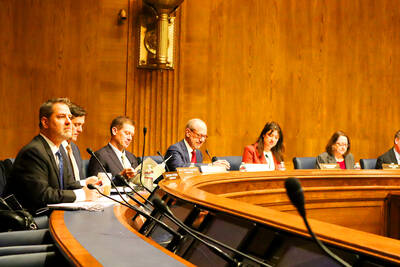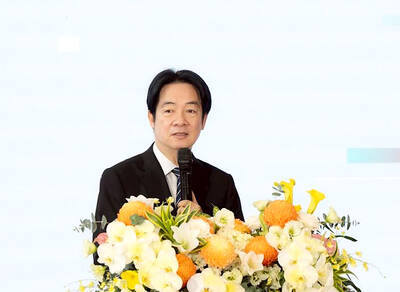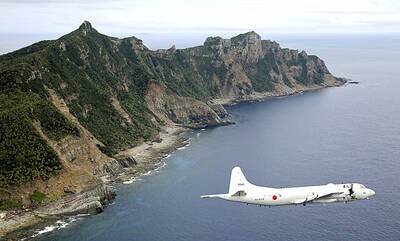Defense experts and officials in Taipei and Washington had mixed reactions to the embarrassing news, published on Monday by Defense News and Kyodo news agency, that security at a key signals intelligence facility in northern Taiwan was so lax that neighboring cows were observed walking freely around the base.
Located in Linkou (林口), Taipei County, Linyuan Base collects imagery and signals intelligence deep inside China and at sea.
The facility, which is operated by the Ministry of National Defense’s (MND) ultra-secret Office of Telecommunication Development (OTD), General Staff Headquarters, was built in 2000 and started operations in 2003, Defense News wrote.

PHOTO COURTESY OF WENDELL MINNICK
Kyodo said construction of the OTD facility cost more than NT$4 billion (US$124 million).
Consisting of a large building for data processing, barracks, a number of satellite dishes and two Circularly Disposed Antenna Arrays (CDAA), or “crop circles” that detect the direction of radio signals, the site has been described by local sources as a combination of the US’ National Security Agency (NSA) and National Reconnaissance Office.
The facility has a range of about 5,000km and can cover all of China, and the larger of the two CDAAs is still, according to Desmond Ball, a signals intelligence expert, “the most important high-frequency radio interception and direction-finding station in Taiwan.”
Ball also told Kyodo that the base is important for maritime surveillance and to track People’s Liberation Army Navy (PLAN) ships.
Despite the importance of the base, a work order by the defense ministry said the perimeter fence is “insufficiently high,” adding “in several places, the fence has toppled over or is leaning, with cows breaching the perimeter on several occasions.”
“The fence is not serving its purpose and poses the greatest threat to base security,” the report for the upgrade project says.
Both antenna arrays are accessible either by car, unpaved roads or private land, Kyodo wrote
During a recent visit, there were no guards and no signs of surveillance cameras along the perimeter, though razor wire and some makeshift fences appeared to have been recently laid, preventing the cows from entering the premises, Kyodo reported.
On two separate visits, journalists were able to walk around the base, without being intercepted by guards.
Despite the glaring security shortcomings, an infrastructure upgrade project may not be completed until January 2012, Kyodo reported, adding that from the total budget of NT$107.3 million set aside for the upgrade, only NT$3.1 million, or 3 percent, was allotted last year, while a little more than NT$70.5 million, or 66 percent of the total budget, is to be spent this year.
Asked for comment, John Pike, director of the Global Security think tank in Washington and one of the most respected military and intelligence analysts in the US, told the Taipei Times: “Presumably, if there was an actual need for the fence, it would be in good repair. On the other hand, seriousness and sense of purpose have not always been evident in Taiwanese military preparedness.
“It could be symptomatic of a lax approach, a certain carelessness — and that’s serious,” he said.
“Letting the fence fall down does qualify as being newsworthy and needs some special explanation because it is contrary to common sense,” Pike said.
"This is troubling news,” said Toshi Yoshihara, associate professor of strategy at the US Naval War College and an expert on the PLAN. “Taiwan is already in a precarious strategic position given emerging doubts about its capacity to withstand a knockout blow from Chinese missile barrages.”
Given the facility’s role in monitoring enemy troop movement, it would likely be a primary target for such attacks by China.
“If Taiwan hopes to assert some level of sea control over its littoral environment in accord with its current naval strategy, then it needs the capabilities to maintain the maximum level of battlefield awareness at sea,” he said.
Officials with the Pentagon and the NSA refused to comment on the fence situation.
A US intelligence official said the “Taiwanese intelligence picture” was “too sensitive” to discuss even off the record.
A retired US naval officer who once held a very senior position at the Pentagon and speaking on the strict understanding of anonymity said he was particularly surprised that security had not been tightened over the past few weeks as the crisis in the Korean Peninsula developed.
With the US Navy set to join South Korea in naval exercises, Taiwan may be expected to monitor the PLAN very closely.
Speaking on condition of anonymity, a former National Security Council official under former president Chen Shui-bian’s (陳水扁) administration said no civilian officials, be they from the Democratic Progressive Party or the Chinese Nationalist Party (KMT), have paid attention to security at the base, as it is a purely military site. Defense News said the Marine Corps’ 77th Regiment is responsible for security at Linyuan
“I paid several visits to the base,” the former official said. “Wandering cows will not pose any threat to operations at the OTD. All sensitive materials are processed in confined rooms, some even guarded.”
“The Chinese tourist [Ma Zhongfei, 馬中飛] who was caught in an MND recruitment center in Taipei [in May last year] is no less important than [lax security at] the OTD,” he said.
Asked to comment on the situation, ministry spokesman Yu Sy-tue (虞思祖) told the Taipei Times that he contacted the facility in Linkou and was told that the situation, including cows walking around, happened two years ago and that it has since been fixed with wire fences and that “security is now good.”
The Defense News and Kyodo reporters conducted their latest trip to Linyuan one week ago.
ADDITIONAL REPORTING BY RICH CHANG

MISINFORMATION: The generated content tends to adopt China’s official stance, such as ‘Taiwan is currently governed by the Chinese central government,’ the NSB said Five China-developed artificial intelligence (AI) language models exhibit cybersecurity risks and content biases, an inspection conducted by the National Security Bureau (NSB) showed. The five AI tools are: DeepSeek, Doubao (豆包), Yiyan (文心一言), Tongyi (通義千問) and Yuanbao (騰訊元寶), the bureau said, advising people to remain vigilant to protect personal data privacy and corporate business secrets. The NSB said it, in accordance with the National Intelligence Services Act (國家情報工作法), has reviewed international cybersecurity reports and intelligence, and coordinated with the Ministry of Justice Investigation Bureau and the National Police Agency’s Criminal Investigation Bureau to conduct an inspection of China-made AI language

LIMITS: While China increases military pressure on Taiwan and expands its use of cognitive warfare, it is unwilling to target tech supply chains, the report said US and Taiwan military officials have warned that the Chinese People’s Liberation Army (PLA) could implement a blockade within “a matter of hours” and need only “minimal conversion time” prior to an attack on Taiwan, a report released on Tuesday by the US Senate’s China Economic and Security Review Commission said. “While there is no indication that China is planning an imminent attack, the United States and its allies and partners can no longer assume that a Taiwan contingency is a distant possibility for which they would have ample time to prepare,” it said. The commission made the comments in its annual

‘TROUBLEMAKER’: Most countries believe that it is China — rather than Taiwan — that is undermining regional peace and stability with its coercive tactics, the president said China should restrain itself and refrain from being a troublemaker that sabotages peace and stability in the Indo-Pacific region, President William Lai (賴清德) said yesterday. Lai made the remarks after China Coast Guard vessels sailed into disputed waters off the Senkaku Islands — known as the Diaoyutai Islands (釣魚台) in Taiwan — following a remark Japanese Prime Minister Sanae Takaichi made regarding Taiwan. Takaichi during a parliamentary session on Nov. 7 said that a “Taiwan contingency” involving a Chinese naval blockade could qualify as a “survival-threatening situation” for Japan, and trigger Tokyo’s deployment of its military for defense. Asked about the escalating tensions

DISPUTE: A Chinese official prompted a formal protest from Tokyo by saying that ‘the dirty head that sticks itself out must be cut off,’ after Takaichi’s Taiwan remarks Four armed China Coast Guard vessels yesterday morning sailed through disputed waters controlled by Japan, amid a diplomatic spat following Japanese Prime Minister Sanae Takaichi’s comments on Taiwan. The four ships sailed around the Senkaku Islands — known as the Diaoyutai Islands (釣魚台) to Taiwan, and which Taiwan and China also claim — on Saturday before entering Japanese waters yesterday and left, the Japan Coast Guard said. The China Coast Guard said in a statement that it carried out a “rights enforcement patrol” through the waters and that it was a lawful operation. As of the end of last month,